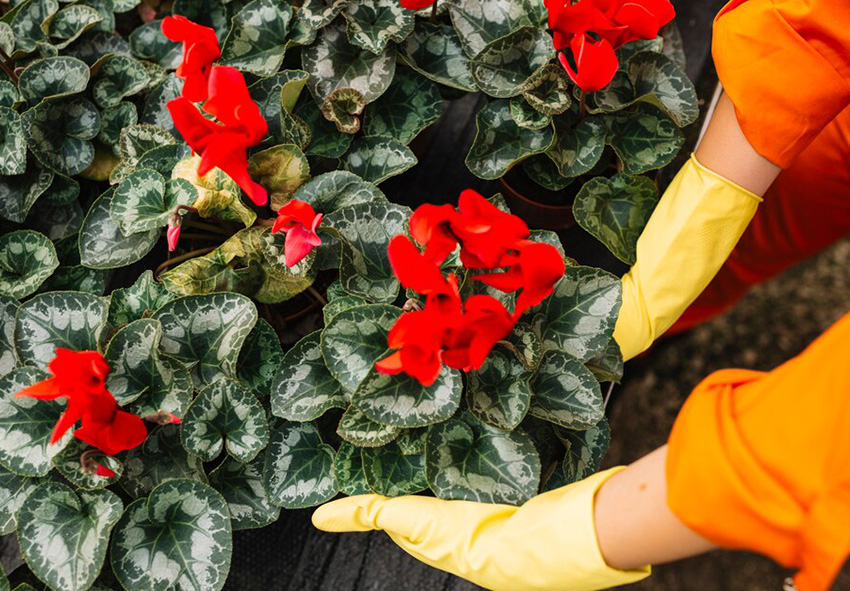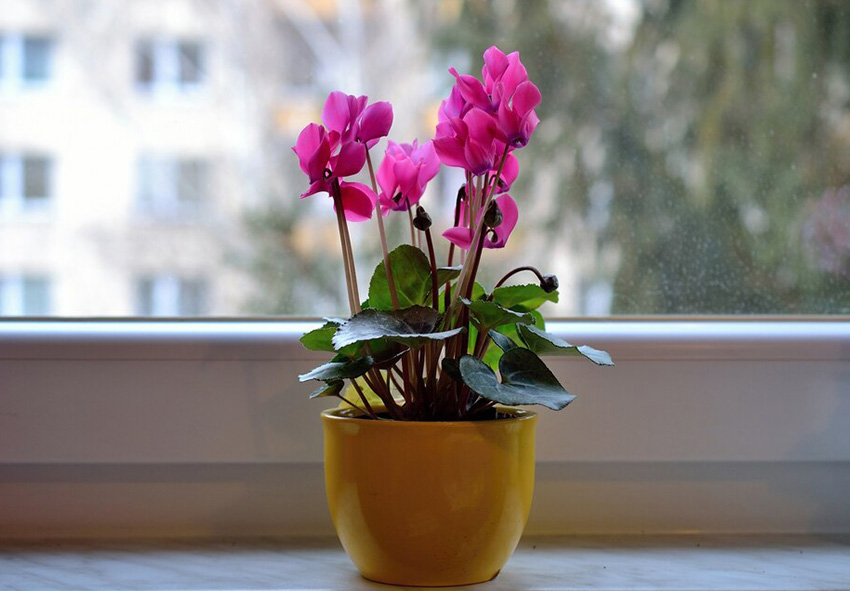If you are looking for a plant that delicately adds color and beauty to your garden or home interior, look no further than the Cyclamen. This stunning plant is not only aesthetically pleasing, but it is also easy to care for. In this article, we will explore the various aspects of planting Cyclamen and provide you with useful tips to ensure that your plant thrives.
Understanding Cyclamen Growth and Habitat:
Cyclamen, sometimes referred to as Sowbread, thrives as a perennial plant native to the Mediterranean area. This captivating botanical marvel exhibits leaves shaped like hearts and possesses remarkable, aromatic flowers that showcase a captivating array of pink, red, and white hues.
Cyclamen plants flourish in cooler temperatures, making them ideally suited for planting during the autumn and winter seasons. When cultivated indoors, these charming plants can grace your living space with their blossoms for a remarkable duration of up to three months, infusing joy and beauty into your surroundings.
Selecting the Ideal Planting Time for Cyclamen:

For optimal growth, it is advisable to plant Cyclamen during the autumn or winter seasons. This timing allows the plant to establish its root system and initiate growth prior to the onset of scorching summer temperatures. Selecting a shaded or partially shaded area is crucial, as direct sunlight can be detrimental to the well-being of Cyclamen plants.
When preparing the planting site for Cyclamen, prioritize a well-drained location with a soil pH ranging from 6.0 to 7.5. These plants thrive in soil enriched with organic matter, such as compost or peat moss. It is vital to maintain adequate soil moisture without excessive wetness, as overly saturated conditions can lead to the development of root rot.
Assessing Soil Conditions for Cyclamen:
Prior to the planting of Cyclamen, it is crucial to evaluate the soil conditions. Optimal growth for Cyclamen plants is achieved in well-drained soil that is abundant in organic matter. Care should be taken to avoid excessive soil moisture, as it can contribute to the development of root rot. Enhancing the soil with compost or other organic materials aids in improving drainage and supplies the necessary nutrients for the plant’s thriving.
When selecting a planting spot for Cyclamen, prioritize a well-drained location with a desirable soil pH range of 6.0 to 7.5. Cyclamen plants thrive in soil enriched with organic matter like compost or peat moss. It is vital to maintain an appropriate soil moisture level, ensuring that it does not become overly saturated, as this can lead to detrimental root rot.
Step-by-Step Guide for Planting Cyclamen Bulbs:
Having assessed the soil conditions and determined the perfect spot, it’s time to proceed with planting your Cyclamen bulbs. Follow these straightforward steps to ensure a successful planting:
- Select a shaded or partially shaded location with well-drained soil.
- Dig a hole that is twice the size of the Cyclamen bulb.
- Place the bulb in the hole, ensuring that the pointy end faces upward.
- Cover the bulb with soil, leaving the tip exposed.
- Thoroughly water the plant.
If planting Cyclamen indoors, it is advisable to use a well-draining potting mix enriched with organic matter. Additionally, ensure that the pot has proper drainage holes to prevent water accumulation, which could lead to root rot.
Essential Care Practices for Cyclamen:

To ensure the thriving of Cyclamen plants, minimal care practices should be followed. Here are some essential guidelines to keep in mind:
- Maintain regular watering, ensuring not to overwater the plant.
- Apply fertilizer every two weeks during the growing season.
- Remove any dead leaves and flowers to stimulate new growth.
- Provide adequate ventilation to prevent excessive humidity.
Cyclamen plants flourish when kept in cooler conditions, with temperatures ranging from 40 to 70 degrees Fahrenheit. When watering your Cyclamen, take care to avoid wetting the leaves or flowers, as this can lead to rotting.
Encouraging Cyclamen Blooming and Longevity:
Cyclamen plants typically bloom for several weeks during the fall and winter months. To encourage blooming and longevity, it is important to provide the plant with the following:
- Adequate water and fertilizer.
- Shaded or partially shaded location.
- Cool temperatures.
When the flowers begin to fade, remove them to encourage new growth. With proper care, your Cyclamen plant can bloom for several months, bringing beauty and joy to your home.
Addressing Common Cyclamen Challenges:

Although Cyclamen plants are generally low-maintenance, they may encounter certain challenges. Here are some common issues and their respective solutions:
- Yellowing leaves: This often indicates overwatering. Adjust your watering routine, allowing the soil to dry out more between watering sessions. It is crucial to ensure that the soil has proper drainage to prevent waterlogged conditions.
- Brown spots on leaves: Brown spots can be an indication of excessive sunlight exposure. Relocate the plant to a shaded area where it can receive filtered or indirect light.
- Lack of blooms: Insufficient watering or fertilization can contribute to a lack of blooms. Ensure that the plant is adequately watered, providing moisture without overdoing it. Additionally, follow a regular fertilization schedule to supply the necessary nutrients for healthy blooming.
By addressing these common issues and implementing the suggested solutions, you can help your Cyclamen plants thrive and overcome potential challenges.
Conclusion:
Cyclamen, with its enchanting allure, serves as an exquisite addition to any garden or indoor setting. Its beauty and ease of care make it a delightful choice for plant enthusiasts. By adhering to the tips provided in this guide, you can ensure the thriving and prolonged blooming of your Cyclamen plant, allowing it to grace your surroundings with its delicate splendor for years to come. With just a touch of care and attention, you can confidently cultivate Cyclamen and appreciate its timeless elegance.
Frequently Asked Questions (FAQs) about Cyclamen
1. Can I order Cyclamen (Sowbread) plants from your online store?
Yes, you can! Our online store offers a wide selection of Cyclamen plants, including different varieties and colors. We take pride in providing top-quality plants that are carefully cultivated and shipped with care to ensure they reach you in perfect condition. Visit our online store to explore our collection and place your order for a delightful addition to your home or garden.
2. What are the ideal growing conditions for Cyclamen plants?
Cyclamen plants thrive in cool, well-lit environments. They prefer indirect sunlight or bright, filtered light. It’s important to keep them away from direct sunlight, as it can scorch their leaves. The ideal temperature range for Cyclamen is around 50-60°F (10-15°C) during the day and slightly cooler at night. They also require well-draining soil and should be watered from the bottom to prevent water from sitting on their corms (bulb-like structures). Cyclamen go through dormancy periods, usually during the summer, where they should receive less water. During their growing season in fall and winter, you can increase watering frequency.
3. How do I propagate Holland Cyclamen plants?
Cyclamen can be propagated through seeds or by division. Propagating from seeds can be a bit challenging due to their specific requirements, including cold stratification. It’s often easier for home gardeners to propagate Cyclamen by dividing mature plants. Wait until the plant is dormant in the summer, then carefully lift the corms, separate them, and replant them in well-draining soil. Each division should have a corm with roots and leaves attached. Keep the new divisions in a cool, shady spot until they establish themselves.
4. Do Cyclamen require any special care during their dormant period?
Yes, Cyclamen go through a natural dormancy period during the summer months. During this time, you should reduce watering significantly, allowing the soil to dry out slightly between waterings. It’s also a good idea to stop fertilizing the plant during dormancy. Keep the plant in a cool, shaded area, but do not store it in a completely dark location, as Cyclamen still require some light, albeit minimal, during dormancy. When you notice new growth starting in the fall, gradually increase watering and move the plant back to its regular location with filtered light.
5. What common pests and diseases should I watch out for with Cyclamen?
Cyclamen are relatively resilient to pests and diseases, but they can occasionally encounter issues like aphids, spider mites, or fungal diseases. Regularly inspect your plants for any signs of these problems. If you notice pests, you can use insecticidal soap or neem oil to treat them. To prevent fungal diseases, avoid overwatering and ensure good air circulation around the plants. Always remove any dead or yellowing leaves promptly to discourage disease development. Proper care, including providing the right environment and avoiding overwatering, is the best way to keep your Cyclamen healthy and pest-free.
Published: 07.06.2023
